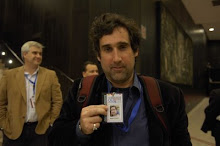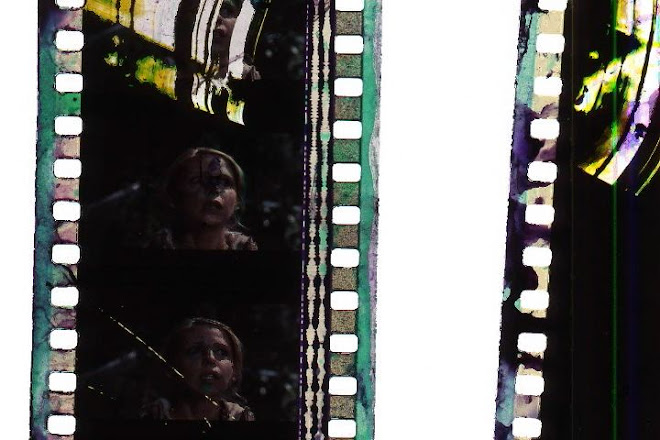
This article was published in the now defunct RELEASE PRINT, magazine of San Francisco's lovely FILM ARTS FOUNDATION in March/April 2007
film is dead, long live film by Mark StreetIn 1994 the San Francisco Police Department evacuated a whole block in the Mission District and blew up a home-made battery pack I’d made for my 16mm Bolex camera.
I had left the battery pack in the storage area of my girlfriend’s house along with broken suitcases, camping equipment and other boheme detritus that everyone seemed to leave on Cumberland St. All of our apartments were small, and my girlfriend and her sister had storage area to spare. The battery pack consisted of 4 lantern batteries in their original cardboard box, fastened with duct tape, with a single green wire protruding from the box to be attached to motor and then to the camera. My girlfriend’s sister saw the wire and box peeking out from the storage area as she parked her car in the garage and called the police.
After hearing about what had happened, I called one Sergeant Donahue to explain the situation.
“It was a battery pack for a film camera. I just wanted you to know it wasn’t a bomb.”
This was yesterday’s news to Sergeant Donahue.
“As far as I’m concerned this case is closed” he said and hung up. Bomb or no bomb, battery pack or no battery pack, that particular item was history.
I don’t miss that battery pack. It was cumbersome and I only used it on a few occasions, to shoot clouds in slow motion moving across the Bernal Heights skyline for my diary film Lilting Towards Chaos. But I hated to hear the policeman slam down that phone with such finality. It felt like an end, for me. The object itself held little significance, but the ethos of figuring out how to jerry rig something to fit onto a camera, those days seemed irretrievable all of a sudden.
It’s a much better story than it was useful object, and like some people it made more of a splash in death than it did in life. Maybe so it will be with film, better as a wisp of an ideal, a memory of a fleeting imperfect shadowplay across a white screen in the dark than the experience ever was. Film going was always just short of a dream— a sensual engagement rather than an object, an ephemeral event hard to contain and define.
I feel like I’ve been waiting for film to die my whole adult life. At Bard College in the mid 80’s the slick film majors had anecdotes and evidence about the end of celluloid. “It’ll all be video by next year” intoned Jed from Long Island, who I remember drove his red Porshe into a tree one drunken night. I shrugged at Jed’s dire predictions and went on scratching on black leader.
In the early 90’s I would tote my 16mm prints all over the country, only to have some curators take a quick took at the cans and say “Can’t we just show your stuff on VHS?” I shrugged it off.
In the late 90’s a got more calls then I needed from people GIVING AWAY flatbed editors and film prints, would I take them, please? As Baltimore’s City Salvage , (a repository for all the overflow of taxpayer purchased objects) closed its doors, I dutifully made a trip out there and loaded up my car with unwanted 16mm prints: Life of a Grasshopper, A Chance to Live: Nuclear Disaster and Blow, Wind, Blow, among others.
“I don’t know how many more 16 mm films I have in me” I heard filmmaker after filmmaker say to me. This from the people who’d moved over to video. I can’t hold any kind of media choice against any working artist, so I shrugged some more.
I shrugged when the film departments where I have taught (in Florida, Baltimore and NYC) stopped paying to rent 16mm films.
I’ve never been a purist. Purism, like perfectionism, strikes me as some kind of ultimate hubris, as if one is taking one’s art too seriously, and the gods are waiting around the corner with a big stick. And yet I’m awkward with the transition, the inevitability of it all, the surging sense of loss.
The other day some students from the film preservation/archiving program at NYU came over to my house to help me store some of my film materials safely. They labeled everything with bright blue tape, inspected my prints and outtakes, and arranged everything neatly. I kept trying to get these folks to loosen up as they worked, feeling like they’d made it out to Brooklyn to do me a favor, of sorts, albeit one they were getting college credit for. But they had a sort of grim determination, like coroners or embalmers, as they adjusted a humidifier, inquired about the nature of the splices on my workprint, and stacked my plastic cores in rows.
I used to encourage my students to buy old cameras and projectors, dumpster dive at libraries giving away their collections, process their own film, engage the medium in some sort of punk, DIY aesthetic. But film is no longer the detritus of the culture, and using it is no longer a considered reaction against planned obsolescence. Film is the old grandfather in the corner who is demented and senile and repeats himself over and over again. It’s not underground, hip, indie or pure. It’s expensive and all but dead.
Ah, but we’ve lost some things. I remember watching my 8 minute film Echo Anthem (comprised of 16mm footage of the 1989 SF earthquake) 40 times in one weekend when I first got it back from the lab. The images flickered on my wall, and my cigarette smoke mingled with the projected light. It isn’t the same when you get a tape back from the lab. I remember seeing Stan Brakhage’s Mothlight for the first time, feeling like my world was shaken. It’s not the same on DVD. Just the other day I projected a print of Ernie Gehr’s Table. The colors were so vibrant, the screen so deep I felt like I was going to sink into it. With work like this, it’s not a question of degree—you simply can’t “get it” on tape or disk. For all practical purposes, those films don’t exist anymore.
Festivals don’t show 16mm much any more. For a stretch I made 35mm prints, but the expense made me wonder if I wasn’t being vain and hubristic in a new way. I send out tapes and disks, and festivals are overwhelmed with a glut of work made digitally which they slog through as best they can. It’s wonderful that more people can make more work except when it’s not: when quantity doesn’t equal quality and one yearns for the days when an idea had to be nurtured and worked, considered, and yes, paid for in order to be articulated. Maybe I’m more classist than I ever knew, and I miss the days when moving image making was not quite as populist.
The other night I drove to Williamsburg Brooklyn to check out the brand new moving image venue I’d heard about. Hipsters flocked on street corners, charting their pub crawls which start at 11 pm. Comic book and record (I mean CD) stores dot the landscape.
Monkeytown is a 50 foot square room with a 20 foot high screen on each wall. The video projection equipment sits in the middle of the room, and you sit facing one of the four walls, with all screens in view except the one behind you. They project feature films on video (2 at a time), documentaries and artists’ works. The night I went I saw abstract digital work shimmering on the screen as waitresses clad in work suits brought spicy meatballs and sesame oil baked codfish. After a few vodkas and glasses of white wine I settled back to watch the show, content to be slumping back and seeing images unfold, at once alone and in company, not quite in the dark, but almost.
I’ve always resisted the elegiac with regards to film, this most 20th century of mediums. Things change, and who cares about the actual stuff of film? The ideas that animated film as film are still alive and well and inspiring a generation of moving image makers who are hunched over their video editing equipment at home. But I wished I’d heard the clickety clack of a 16mm projector that night at Monkeytown, or seen a splice jump out of the gate. I miss total darkness, and scratching on the emulsion of found footage films. And I’m not shrugging off the demise of film anymore.
















